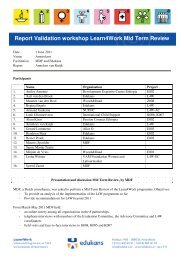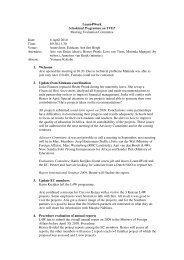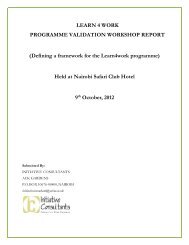Non â Formal TVET Mapping Survey Supported by Edukans ...
Non â Formal TVET Mapping Survey Supported by Edukans ...
Non â Formal TVET Mapping Survey Supported by Edukans ...
Create successful ePaper yourself
Turn your PDF publications into a flip-book with our unique Google optimized e-Paper software.
<strong>Non</strong> – <strong>Formal</strong> <strong>TVET</strong> <strong>Mapping</strong> <strong>Survey</strong> The case of Amhara, Oromia and Addis Ababa<br />
Within the framework of the Education and Training Policy the first, second and third<br />
Education Sector Development Strategies have been developed and implemented since<br />
1997. This has enabled to offer formal and non-formal technical and vocational<br />
education. <strong>Formal</strong> Technical vocational Education and Training is offered to school<br />
leavers from grade 10 running parallel to the regular education system. Certificates and<br />
diplomas are awarded to those who complete the one to three years of program. The<br />
<strong>TVET</strong> fields of specialization have reached to 25 and the number of increased<br />
enormously.<br />
ESDP I focused on providing quality primary education with the ultimate aim of attaining<br />
universal primary education in 2015. It was ESDP III that gave better emphasis in<br />
particular to non-formal education. The adult and <strong>Non</strong>-<strong>Formal</strong> education program<br />
includes a range of basic education and training components for children and adults who<br />
are out of school age children of 7-14, a literacy program for youth and adults who are<br />
older than 15, and basic skills training to youth and adults in the community skill training<br />
center.<br />
The national education and training policy and the strategies are highly interrelated to the<br />
statements made in the Dakar Framework for Action. The points remotely connected to<br />
<strong>Non</strong> <strong>Formal</strong> <strong>TVET</strong> are the following.<br />
Achieve a 50% improvement in levels of adult literacy <strong>by</strong> 2015 especially for<br />
<br />
women and equitable access to basic and continuing education for all adults.<br />
Improve and ensure excellence in all aspects of the quality of education, so that<br />
recognized and measurable learning outcomes are achievable <strong>by</strong> all especially in<br />
literacy and numeracy, numeracy and life skills.<br />
These points have been taken bases .for strengthening, designing and implementing <strong>Non</strong>-<br />
<strong>Formal</strong> <strong>TVET</strong> programs and projects. <strong>Non</strong>-formal <strong>TVET</strong> is taken as an organized<br />
training given to the unemployed, the poor, youths and adults for a period less than six<br />
months. Its prime objective is alleviating poverty and promoting development. Although<br />
there are experiences of providing <strong>Non</strong>-<strong>Formal</strong> <strong>TVET</strong> programs in the country there is<br />
very little documented information regarding details of conditions of trainings given and<br />
success stories.<br />
3.3. The Indian experience<br />
Thom (2007) asserts that training given has to be related to locally available resources<br />
and market opportunities. Areas of training could be:<br />
Using available plots of land for agriculture and horticulture-growing vegetables,<br />
fruits, flowers, etc.<br />
Small animal rearing – chicken, rabbits, guinea pigs, sheep goats, pigs, etc.<br />
Local craftwork – bamboo work, beadwork, choir work, etc.<br />
He further states that training given for 14- 18 year olds has to lead for self- employment<br />
that enables them to be able to earn substantial income on sustainable basis. In contrast to<br />
training given for wage employment, training imparted for self-employment has to be:<br />
Education Expertise Center Feb 2008 17







